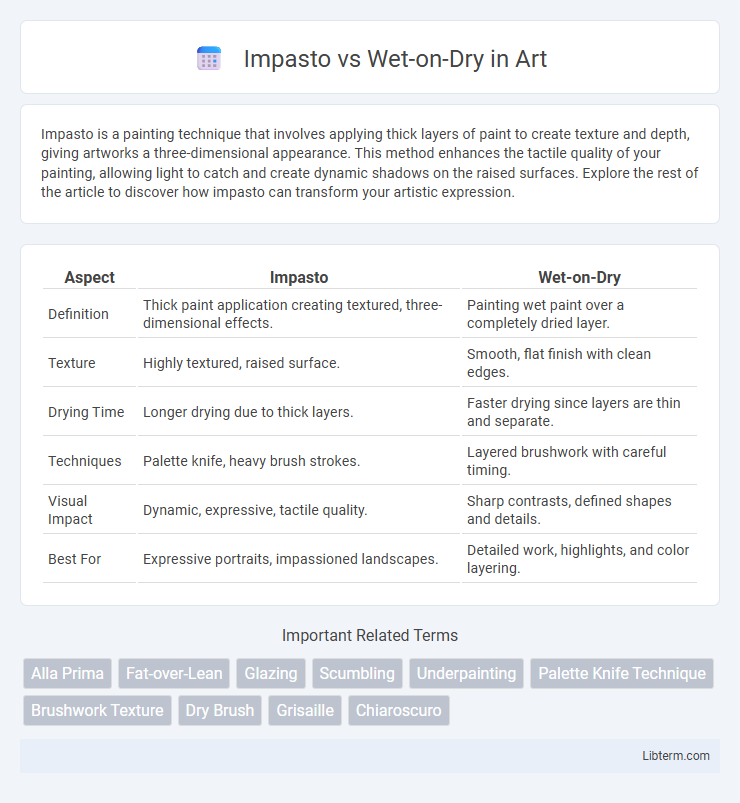Impasto is a painting technique that involves applying thick layers of paint to create texture and depth, giving artworks a three-dimensional appearance. This method enhances the tactile quality of your painting, allowing light to catch and create dynamic shadows on the raised surfaces. Explore the rest of the article to discover how impasto can transform your artistic expression.
Table of Comparison
| Aspect | Impasto | Wet-on-Dry |
|---|---|---|
| Definition | Thick paint application creating textured, three-dimensional effects. | Painting wet paint over a completely dried layer. |
| Texture | Highly textured, raised surface. | Smooth, flat finish with clean edges. |
| Drying Time | Longer drying due to thick layers. | Faster drying since layers are thin and separate. |
| Techniques | Palette knife, heavy brush strokes. | Layered brushwork with careful timing. |
| Visual Impact | Dynamic, expressive, tactile quality. | Sharp contrasts, defined shapes and details. |
| Best For | Expressive portraits, impassioned landscapes. | Detailed work, highlights, and color layering. |
Introduction to Impasto and Wet-on-Dry Techniques
Impasto technique involves applying thick layers of paint, creating texture and depth that catch light and emphasize brushstrokes or palette knife marks. Wet-on-dry technique requires painting wet paint onto a dry surface, allowing for sharp edges, precise details, and layered color control. Both methods offer distinct visual effects, with impasto adding physical dimension and wet-on-dry enabling refined layering and clarity.
Defining Impasto: Characteristics and Materials
Impasto is a painting technique characterized by thick, textured layers of paint that create a three-dimensional effect on the canvas. Artists typically use heavy-bodied acrylics or oil paints, applied with palette knives or stiff brushes, to achieve pronounced ridges and tactile surfaces. This method emphasizes light reflection and shadow, enhancing the visual depth and dynamic quality of the artwork.
Wet-on-Dry Explained: Process and Results
Wet-on-Dry painting involves applying wet paint onto a dry surface, allowing for precise edges and layering without color blending, ideal for detailed work and controlled textures. This technique creates distinct layers as each layer dries before the next is added, resulting in sharper contrasts and enhanced depth in the artwork. Artists using wet-on-dry can achieve a clean, structured composition with well-defined forms compared to the more blended effects of impasto or wet-on-wet methods.
Historical Origins of Both Techniques
Impasto, originating in the Renaissance period, was popularized by artists like Rembrandt and Van Gogh who used thick, textured paint to add dimension and emotional intensity to their works. Wet-on-dry technique, rooted in classical oil painting traditions, involves layering dry paint over dried layers to achieve precision and detail, prominently used by Baroque masters such as Caravaggio. Both techniques reflect distinct historical approaches to texture and layering, shaping the evolution of Western painting styles.
Key Differences Between Impasto and Wet-on-Dry
Impasto technique involves applying thick layers of paint to create texture and dimension, while wet-on-dry means painting wet paint over a dry layer for sharper edges and controlled blending. Impasto emphasizes three-dimensionality through visible brushstrokes and raised surfaces, whereas wet-on-dry prioritizes precision and layering without mixing colors on the canvas. Artists choose impasto for expressive, tactile effects and wet-on-dry for detailed, clean compositions.
Visual Effects: Texture vs. Precision
Impasto technique creates rich, tactile surfaces with thick paint layers that emphasize texture and dynamic light play, enhancing the three-dimensional quality of the artwork. Wet-on-dry technique allows for precise, sharp edges with controlled layering, preserving the clarity of shapes and fine details. Artists choose impasto for expressive, textured effects and wet-on-dry for meticulous, refined compositions.
Choosing the Right Technique for Your Artwork
Impasto technique creates texture and dimensionality by applying thick layers of paint, ideal for expressive, tactile artworks that emphasize brushstrokes and surface detail. Wet-on-dry allows for precise layering and sharp edges by painting over dry layers, making it suitable for controlled compositions and fine details. Selecting between impasto and wet-on-dry depends on the desired texture, drying time, and visual impact to best complement your artistic vision.
Tools and Materials Needed for Each Method
Impasto painting requires thick oils or acrylics, stiff bristle brushes, and palette knives to create textured, three-dimensional effects. Wet-on-dry technique uses thinner paint layers, soft brushes, and smoother surfaces like primed canvas or paper to achieve crisp, defined edges and layers. Both methods benefit from high-quality pigments, but impasto demands more durable tools to manipulate the heavy paint effectively.
Common Mistakes and How to Avoid Them
Impasto often suffers from overly thick applications that crack during drying, so applying consistent, moderate layers and using appropriate mediums prevents texture damage. Wet-on-dry painting commonly features harsh edges and poor blending due to insufficient drying time, which can be avoided by ensuring complete drying between layers and using glazing techniques. Proper surface preparation and patience in layering are essential to mastering both impasto and wet-on-dry methods without common pitfalls.
Expert Tips for Mastering Impasto and Wet-on-Dry
Mastering impasto requires using heavy body acrylics or oil paints with palette knives to create textured, three-dimensional surfaces that capture light and shadow effectively. For wet-on-dry technique, apply paint layers only after the previous one has fully dried to maintain crisp edges and detailed contrast, ideal for precise compositions. Experts recommend experimenting with drying times and layering thickness to balance texture and detail, enhancing depth without compromising control.
Impasto Infographic

 libterm.com
libterm.com